President's Message
The HCHS September 2021 newsletter was already directed for printing when we learned of the August 20th death of Dr. Louis Henry Manarin. We were able to include the notice in memorium but were not able, at that time, to make note of his many contributions to Henrico hisory. When I began to write of Dr. Manarin, there is no tribute better to share with you than what, on October 12th, the Henrico County Board of Supervisors presented his family with the following:
Resolution:
OF THE BOARD OF SUPERVISORS OF HENRICO COUNTY, VIRGINIA
Honoring the Late Dr. Louis Manarin
WHEREAS, Louis H. Manarin was born April 1, 1932 in Washington, D.C.; and
WHEREAS, he attended Valley Forge Military Academy, earned a bachelor's degree from Western Maryland College, and earned master's and doctoral degrees from Duke University; and
WHEREAS, From 1696 to 1995, Dr. Manarin served as the State Archivist for the Virginia State Library, which became known as the Library of Virginia in 1994; and
WHEREAS, Dr. Manarin authored, coauthored, or edited over one dozen books and numerous other documents recounting various historical events within Virginia and North Carolina; and
WHEREAS, Dr. Manarin featured extensive accounts of Henrico County's history in the following works: The History of Henrico County (coauthored by Clifford Dowdey); Henrico County Field of Honor, Volumes I and II; Henrico County-Images of America; and The History of Henrico County-400th Anniversary Edition (coauthored by Charles H.Peple); and
WHEREAS, because of his extensive background in historical research, Dr. Manarin was appointed to several Henrico County committees, including the Historic Preservation Advisory Committee of which he was a founding member; the Henrico County Historical Society of which he served as inaugural editor of the group's print publication, and the Henrico County 2011 Commemoration Commission; and
WHEREAS, after a lifetime fo research and chronicling history, Dr. Manarin passed away at 89 years of age on August 20, 2021
NOW, THEREFORE, BE IT RESOLVED that the Board of Supervisors of Henrico County, Virginia, wishes to recognize the late Dr. Louis H. Manarin for his meticulous research and preservation of the story of Henrico County by naming the North Park Branch Library's meeting room in his honor.
BE IT FURTHER RESOLVED that the Cleark of the Board of Supervisors shall prepare a copy of this resolution for display in the North Park Branch Library as a sincere expression of the County's appreciation for Dr. Manarin's service.
Signed,
Daniel J. Schmitt, Chairman
Board of Supervisors
and
Tanya Brackett, Clerk
October 12, 2021
At this time of the year when we give thanks, we will be forever grateful for Dr. Manarin's contribution to Henrico history; and I am thankful to have called him friend.
Sarah Pace
President
>Back to Top<
December Quarterly Meeting
Our December Quarterly Meeting will take place on Sunday, December 5th, starting at 2:30 p.m. It will be at The Parson's Center at Meadow Farm Crump Park; the address is 3400 Mountain Road in Glen Allen, VA 23060.
Bryce Stanley will provide a presentation about the Parson family. Kim Sicola will provide a presentation about the Sheppard family.
>Back to Top<
It's Dues Time
Please take a few minutes to fill out the attached envelope, write a check and renew your membership. If there's no envelope here, we thank you for your Life Membership or your early payment for for being a partner organization.
>Back to Top<
In Memorium: William "Bill" LaVecchia
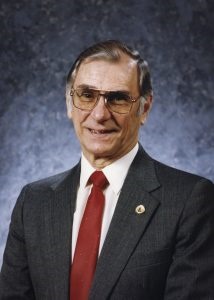
Bill LaVecchia was born in 1926, and past away in 2021.
He served as the Henrico County Manager from 1984 to 1992.
Our condolences to Bill's family.
>Back to Top<
Impending Construction Start Has Them Digging into the Past at Meadow Farm
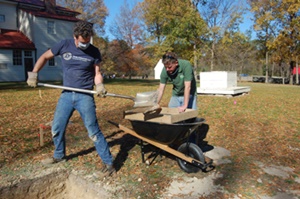
The contract has been awarded, and Brooks & Co. Construction is set to start building the kitchen at Meadow Farm. Construction is slated to begin the week of November 22, and the kitchen should be completed in ninety days.
In preparation for the work, the county hired archaeologist Darby O'Donnell to work with county archivist Bryce Stanley to assure that important historical artifacts are not affected by the construction. They dug test holes and then selected a small area for a test dig. In the picture at the left, Darby O'Donnell takes a shovel of soil from that square test hole at his feet and drops into the sieve where Bryce Stanley searches for artifacts in what the sieve catches.
So it looks as if they will really be cooking at Meadow Farm in the near future.
>Back to Top<
Growing County Concerns
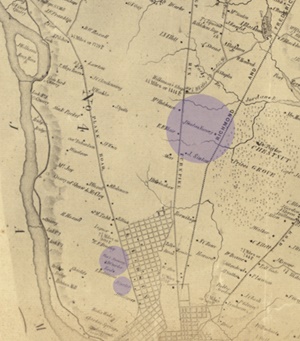

Having fostered the formation of nine counties and part of another, Henrico County might well be seen as a nursery for Virginia growth. And literal nurseries played a role in the development of Henrico County. In his "Sowing New Seeds" chapter in the History of Henrico County, Dr. Louis Manarin recounts the economic growth of the county after the Civil War and points out that "Large orchards of fruit trees were set out after the war." However, those orchards and vineyards were really the return of significant orchards in the county from an earlier time. One apparent center of early to mid-nineteenth century Henrico nurseries now is the site of Richmond homes with landscaped yards - West Cary Street or the old Westham Plank Road. At least two large nurseries, James Via's Nursery and John Carter's Cherry Vale, once could be found there.
It seems that Cherry Vale is the oldest of the three because John Carter announced in the 16 Decmber 1830 Richmond Enquirer that he had spent the previous six years cultivating the land and was "now enabled to offer to the public a selection of Fruit Trees, Grape Vines, &c." His nursery is the first highlighted area at the bottom of the Smith map detail below.
Just up the Westham Road, one found James Via's nursery. In the 8 November 1842 Richmond Enquirer, he offered a wealth of trees for sale, beginning at twenty-five cents each, depending on the number ordered. It is interesting that Norton's Seedling grape vines, developed in Henrico County (see March 2017 Newsletter), are his most expensive item at fifty cents each.
Sinton's Nursery, a bit northwest of the other two and on the Deep Run Turnpike, might have had the largest inventory. Clearly hoping to extend his market well beyond the county, he advertised in the 5 December 1844 Staunton Spectator that he had for sale "60,000 GRAFTED OR BUDDED FRUIT TREES."
Gardens in order: These three ads from the 19 November 1844 Richmond Enquirer illustrate the range of area nursery offerings, and the ads' positions correspond to the order in which they would be found moving westward from Richmond.
>Back to Top<
Inventive Henricoans
While making buttons was a fairly difficult matter for Eighteenth Century button makers, it is a bit difficult to imagine how one could complicate the means of attaching them. However, Willie C. Walter seems to have done just that with his Button-Fastener patent. This 1885 patent is for attaching buttons to clothing or elsewhere. It would apparently have been more durable than thread, and Walter claims it to be an improvement on other contemporary fasteners. His explanation is a bit hard to follow, but the Patent Office apparently thought otherwise.
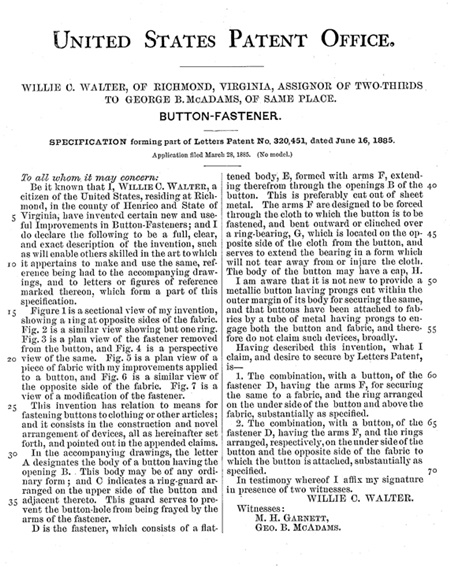
>Back to Top<
Revolutionary War Commissionar of War Requested Help to Button It Up
My wife, my dauther and I are incurable collectors. And our collections have often influenced or inspired the content of this newsletter, while the research done for the newsletter has in turn had its own influence on our collecting. Collecting and saving must be almost genetic, and I think I must have gotten it from my mother, who saved everything, much of which is presently crowded into our living room, including a large bottle full of old buttons. That jar led me to wonder if there had been any button makers in Henrico County. While the search for the answer was not completely satisfeid, the path it led me down was interesting.
It started, as other articles in this newsletter and so many in other newsletters as well, with a look into Dr. Louis H. Manarin's The History of Henrico County. And here I found that those seemlingly insignificant little items, or actually a lack of them, presented a potential problem for Virginia's involvement in the American Revolution.
Dr. Manarin notes in his history that on 21 September 1781, Commissionar of the War Colonel William Davies wrote to Virginia Governor Nelson to express his concern over the inability to complete the production of coats and jackets for the solders due to the lack of buttons. He noted that "this Article, tho' it may seem a trifle, is yet a matter of real importance as the clothing will be retarded for want of them."
Not everyone, however, considered buttons to be trifles. Announcing that "The sloop Congress, belonging to this commonwealth, is safely arrived in James river," the 28 November 1777 edition of the Virginia Gazette listed what it called the ship's "valuable cargo." That valuable cargo included "one hundred and twelve double gross of metal buttons."
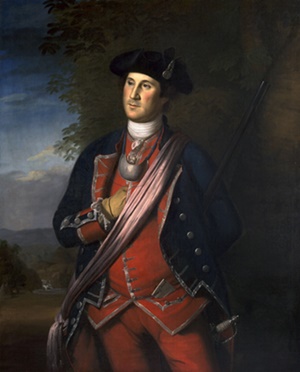
That seems like a lot of buttons, but the Revolutionary coats and jackets were button heavy. A well known picture of George Washington from 1772 shows him clad in the Virginia Militia coat of blue with red facing and white linings and buttons. It featured two rows of eight buttons each. The waistcoat worn beneath it had smaller buttons running from waist to collar.
So Colonel Davies had to procure a large number of buttons in different sizes. The job was large and had to produce buttons according to a set of specifications. In Insignia of Independence: Military Buttons, Accountrement Plates, & Gorgets of the American Revolution, Don Troiani and James L. Kochan quote the specificaiton set down in a Congressional requisition dated April 30, 1778 from a French producer. It required "The Buttons to be Block Tin or Brass and cast solid, with a strong eye or shank, with the letters in Roman letters, on each button."
Certainly, the buttons for Davies would have at least been similar, possibly tin pewter or brass. And it may have been simpler for the producer to use metal stamped or cut out in discs with a metal shank soldered to the back. Even so, such an undertaking was a major production. But Davies had a possible solution.
In his letter to Nelson explaining the problem, Davies went on to say that "one Humphries in the militia of Henrico, now Camp" could make buttons but wanted to be able to do it at home. Unfortunately, it is not at all clear who Humphries was or if Davies' request was granted. The letter was sent in September of 1781, and Revolutionary War records of Henrico before October of that year were burned by the British.
However, the Virginia Militia did not disapper; nor, we imagine did they go without coats and jackets. So buttons must have bene procured. Perhaps, Humphries produced them. And if so, he must have been a person of some means to undertake such a project; and a recommendation to the governor from a man of Davies' position would also seem to imply that he was a person of some degree of importance.
Although no Henrico Humphries or Humphreys could be found in Henrico will books or deeds that might correspond to dates appropriate to the militia man "now at Camp" could be found, it is impossible to resist speculating on his identity. Might he have been someone related to the William Humphries who lived at Malvern Hill, and died in 1687? He married Mary Maxey but his will mentions only his daughter Margaret. So it seems unlikely that our button maker was his descendant.
Might he have descended from a relative of William? A Thomas and a Francis Humphreys are also named along with William in a 1662 patent for neighboring land in Charles City County on the east side of Turkey Creek.
And if we skip ahead to 20 February 1820, Mary Humphries married Nicholas Martin Crots (or Cruts) in Henrico; and John Elliot swore an oath that she was over twenty-one. This seems to indicate that her parents had died and would also suggest an approximate birth date of around 1779. Could she have been the child of our button man?
So the hunt thus far has not been successful, but the hunting trip has been entertaining,; and we would certainly entertain any guidance our readership might offer for grounds to further the search.
Joey Boehling

Button mold and buttons: This wooden-handled mold would mke a set consisting of one large and three small metal buttons.
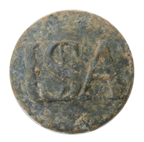
Eighteenth Century buttons: This single French-made Continental Army button is probably like those from the button order dscribed in the article. It is not clear whether or not buttons that Davies would have ordered would have featured the interlocked USA.

French button making shop: This illustration from Denis Diderot's Encyclopedie, ou Dictionnaire raisonne des sciences, des arts et des metiers (Paris, 1765) shows artisans at work and the tools they used in a metal button-making shop.
>Back to Top<
What Do You Know?

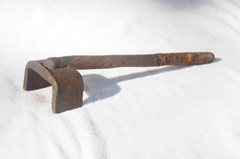
This iron object is 12 inches long. The 1-inch piece affixed to the end is 3-inches wide and 1 1/4-inch deep.
Do you know what it is?
Email your answers to:
jboehling@verizon.net
>Back to Top<
Now You Know - Fashionable Rats
We congratulate Anne Jackson and Valerie Bell, who correctly identified the "What Do You Know" object from the last newsletter as a hair receiver. It was a standard item on a lady's dressing table in the nineteenth and early twentieth centuries.
A lady would collect the hair from her brush, curl it arund her finger and drop it through the hole in the lid. When she had collected a sufficient amount, which would be significant, she would shape it into a sort of tube called a rat. Shen then used the rat as a filler to wrap her own hair around to volumize it.
The term rat seems a bit odd, but it actually refers to the teased or ratted volumizing effect achieved by using a filler hair piece.
Ladies used rats to add volume for the elaborate hairstyles of the Victorian era, as well as for achieving that pompadour or Gibson girl look popular at the turn of the 20th century. They were also used throughout the next few decades for making rolls on the lower back of the head.
The hair receiver pictured in the last newletter is ebonized wood, but rats were also made of glass or crystal with silver or silver plated tops, china, celluloid, and more. They were usually with a powder jar that matched it but had a solid top. The two items often appeared as part of a dresser set, which would include a comb, brush, mirror, and more.
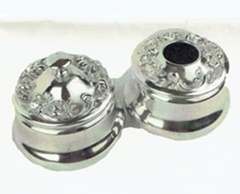
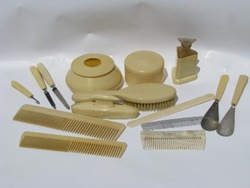
Hair receivers, power boxes, and more: Above is a quadruple silver plated powder box and hair receiver. To the right is an entire lady's dresser set, including combs, brush, perfume or toilet water bottle and manicure tools.


Hair receiver and its owner: Dothora Alice Whitmore (above) used her collected hair from the receiver in the last issue's "What Do You Know?" to aid in fashioning the hair style she is wearing.
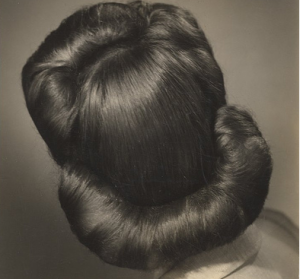
40s style: Rats played a roll in hairstyles well into the forties, as can be seen from the roll at the nape of the woman's neck as well as in the front of her hair.
>Back to Top<
News 2021: Fourth Quarter
First Quarter | Second Quarter | Third Quarter
Home | Henrico | Maps | Genealogy | Preservation | Membership | Shopping | HCHS
|











